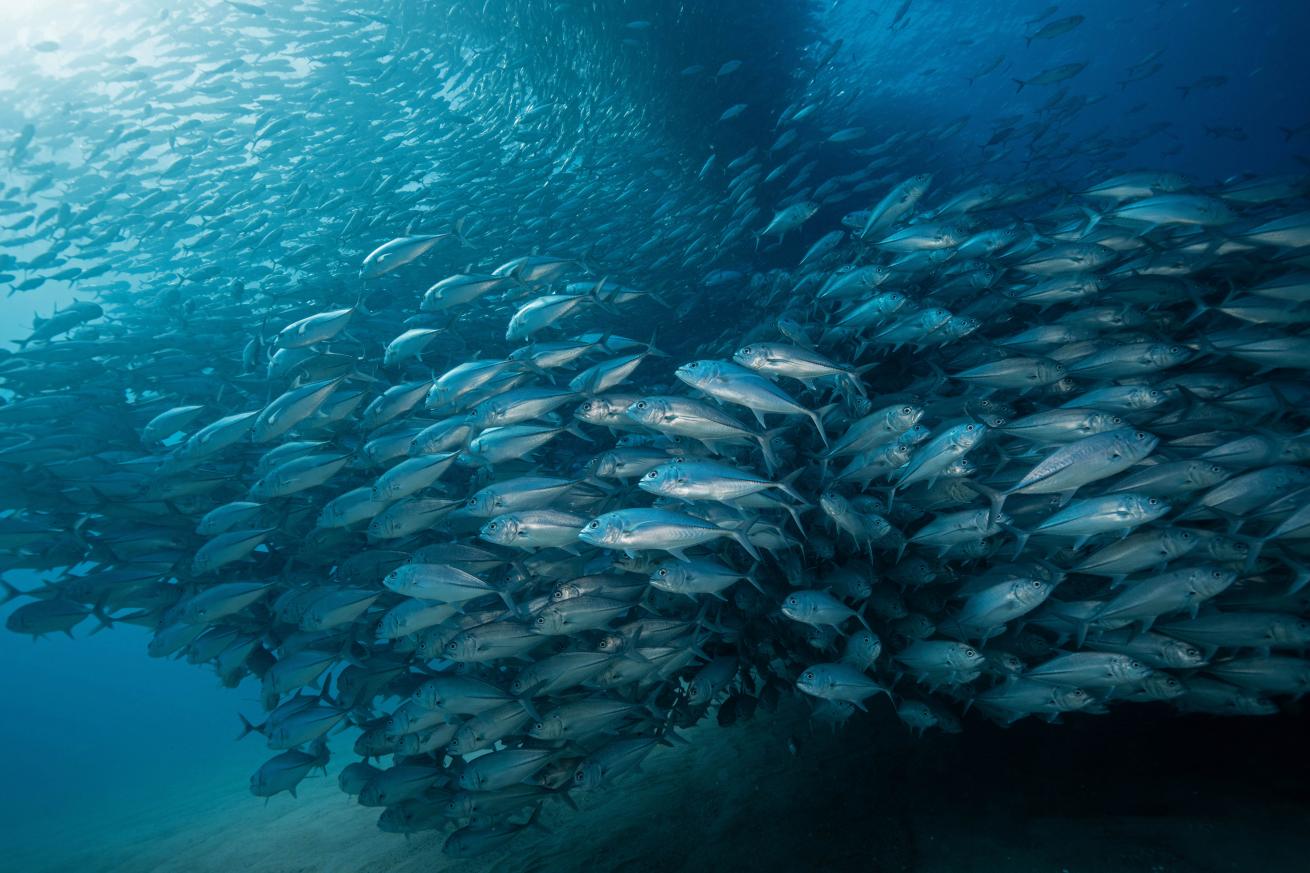Names for Groups of Marine Life That Are Sure to Make You Laugh

Kristin PaterakisBigeye jack, also known as the bigeye trevally, schools in Cabo Pulmo, Mexico.
August marks the arrival of the bustling back-to-school preparations. Indeed, as the weather turns, we imagine floods of students gathering together on campuses and school grounds. Yet beneath the surface, a different species also move in a unison frenzy–akin to their own schools.
While we’re all familiar with “a school of fish” or even “a pod of dolphins,” the names we’ve given to other groups of marine life are as rich as the ocean itself and as whimsical as the creatures they describe.
Here are a few of our favorites.
Collections of Fish
Generally, a group of fish swimming together is called a “shoal;” when a shoal swims in the same direction, it’s called a “school” of fish. Both “school” and “shoal” come from the Dutch word schole, meaning a crowd or troop.
Fish–especially smaller ones–will swim in a synchronized manner in the water (aka “schooling” or “shoaling”) to appear like one larger animal to potential predators and to camouflage with each other. They will also move in unison to find food or mates more easily.
As we get species-specific, our group designations diverge from this more catch-all term. For example, we might dive with a “flotilla” of swordfish, a “battery” of barracudas or an “army” of herring.
Related Reading: I'm From the Shark Bite Capital of the World. Here's Why I Love Diving with One of Nature's Most Misunderstood Predators

Shutterstock.com/Tomas KotoucA fever of rays in Baja California, Mexico.
Mimicking Motion
Some group names describe how aggregations of fish and other marine life move together through the water.
For instance, aggregations of flying fish skimming the water's surface is known as a "glide" or a "squadron." Eels in motion, wriggling and undulating, form a "swarm," a "bed," or a "fry."
The annual upstream migration of salmon to their spawning grounds is aptly dubbed a "salmon run," though it's also fitting to call this collective movement a "run" of salmon.
A “fever” of rays doesn’t refer to their temperature; rather, it’s describing the frenetic activity that large groups of rays have when mating or competing for food in a small area.
Sardines school their entire lives for safety in numbers; under threat, they squash together into giant “bait balls” to stave off predators. Fittingly, their collective is called a “family” of sardines–and families stick together!
Also, we have a “bed” of oysters. This comes from the fact that they’re often found in beds on the ocean floor. Some also say a “hive,” “cluster” or “drift” of oysters.
Related Reading: Winged Wonders: Making the Most of Magical Manta Encounters
Drawing on Characteristics and Behaviors
Celebrated for their remarkable intelligence, a gathering of octopuses is poetically labeled a "consortium". This term aptly highlights their collaborative nature and cognitive prowess.
Even within aquariums, unique naming conventions apply. A “sorority” of female betta fish is a group of female betta fish living together in one tank. A group of goldfish or Koi is called a “troubling” or a “glint”. The latter may describe the shimmering scales of these fish that glint in the light.
The pulsing of jellyfish can look like a flower blooming–especially because they can come in pinks, yellows, blues and purples. Aggregations of these primordial creatures are called “blooms,” “smacks” or “swarms.”
Finally, while groups of squid are technically still called “shoals,” unofficially, many refer to “squads” of squid swimming together and lining up to any diver’s delight. And, just like your squad will defend you and stick by your side, certain squid like the Humboldt are known to travel in numbers reaching 1,200.

Shutterstock.com/Tara LambourneA pod of dolphins.
Inspired by Terrestrial “Cousins”
A group of parrots (the bird) is called a “pandemonium”, perhaps as a nod to their “noisy, chaotic and manic” nature. A collective of parrotfish are called the same.
And, we’ve heard of herds of horses; below the surface, divers with a keen eye might spot a “herd” of seahorses, too.
More Megafauna With Unique Group Names
Of course, charismatic megafauna are a diver’s dream to see in the wild; many also have great collective names for their aggregations.
A group of sharks is called a “school” if it is swimming together in a coordinated manner, like the large schools of hammerheads in the Galapagos Islands; however, when they’re at rest, they’re called a “shiver” of sharks.
Sea otters join together in a “raft”–perhaps referring to how resting sea otters wrap themselves in seaweed to keep from drifting away from each other.
We of course have “pods” of dolphins and whales and “flotillas” or “bales” of sea turtles. Lastly, the rarity of encountering narwhals in the Arctic is commemorated with the term "blessing," a testament to their mythical aura.










